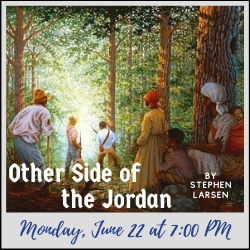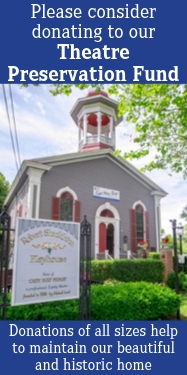Other Side of the Jordan


Monday June 22 at 7:00 PM
To celebrate the opening of the Harriet Tubman Museum in Cape May, Cape May Stage is proud to present a reading of Other Side of the Jordan.
While many know Harriet Tubman as the "Moses of her people," few know that Cape May played an integral part in Tubman's life. This play explores how Tubman became one of the most known conductors of the Underground Railroad while working in Cape May during the summers to pay for her winter abolitionist plans. The play also gives a fascinating look at what life was like in Cape May in 1851 and highlights several other well known abolitionists of the time.
Admission is by donation, and all proceeds will be donated to the Harriet Tubman Museum.
At this point, we optimistically hope to still be able to hold this reading.
To celebrate the opening of the Harriet Tubman Museum in Cape May, Cape May Stage is proud to present a reading of Other Side of the Jordan.
While many know Harriet Tubman as the "Moses of her people," few know that Cape May played an integral part in Tubman's life. This play explores how Tubman became one of the most known conductors of the Underground Railroad while working in Cape May during the summers to pay for her winter abolitionist plans. The play also gives a fascinating look at what life was like in Cape May in 1851 and highlights several other well known abolitionists of the time.
Admission is by donation, and all proceeds will be donated to the Harriet Tubman Museum.
At this point, we optimistically hope to still be able to hold this reading.
Please join us after the reading for a Talk-Back with the cast and creative team to discuss the important themes in the play.
Please be advised:
Other Side of the Jordan contains language including some racial epithets that are true to the period that the play depicts. Such language is not acceptable in modern discourse. Cape May Stage wishes to present this play as it is meant to be performed but does not condone or support the language used in this play.

Information from the Harriet Tubman Museum:
HARRIET TUBMAN’S LIFE AND WORK IN CAPE MAY
 Harriet Tubman lived in Cape May in the early 1850s, working to help fund her expeditions to free fugitives. After her initial journeys transporting fugitive slaves to Canada, her friend and abolitionist leader Franklin Sanborn wrote, “She returned to the states, and as usual earned money by working in hotels and families as a cook. From Cape May, in the fall of 1852, she went back once more to Maryland, and brought away nine more fugitives.” The New Jersey Historical Commission says she spent two other summers in Cape May.
Harriet Tubman lived in Cape May in the early 1850s, working to help fund her expeditions to free fugitives. After her initial journeys transporting fugitive slaves to Canada, her friend and abolitionist leader Franklin Sanborn wrote, “She returned to the states, and as usual earned money by working in hotels and families as a cook. From Cape May, in the fall of 1852, she went back once more to Maryland, and brought away nine more fugitives.” The New Jersey Historical Commission says she spent two other summers in Cape May.
CAPE MAY: A NEXUS BETWEEN NORTH AND SOUTH
Cape May played a pivotal role in the fight to end slavery. Several historic figures critical to the fight against slavery spent their summers in Cape May.
LAFAYETTE STREET AND FRANKLIN STREET: THE CENTER OF ABOLITIONIST ACTIVISM IN CAPE MAY
 The Harriet Tubman Museum building is located on a block that anti-slavery activists called home in Cape May. Lafayette Street and Franklin Street became a center of abolitionist activity centered around three important buildings developed in 1846.
The Harriet Tubman Museum building is located on a block that anti-slavery activists called home in Cape May. Lafayette Street and Franklin Street became a center of abolitionist activity centered around three important buildings developed in 1846.
The Stephen Smith House stands at 645 Lafayette Street, across from the site of the Harriet Tubman Museum, where Stephen Smith built his summer home in 1846. Smith was a founder of the Pennsylvania Anti-Slavery Society.
The Banneker House was next to the Stephen Smith House. The Banneker House became a first-class hotel and one of the only summer resorts for free blacks in the country and was developed by James Harding, a friend of Stephen Smith.
The white Baptist Church was located directly across the street from the Stephen Smith House and Joseph Leach frequently preached there. Leach was a political leader and editor of the Ocean Wave newspaper, where he often wrote accounts of fugitives that fled to Cape May. The congregation of the church issued a strong condemnation of slavery.
Learn more about Harriet Tubman's abolitionist work in Cape May:
Please be advised:
Other Side of the Jordan contains language including some racial epithets that are true to the period that the play depicts. Such language is not acceptable in modern discourse. Cape May Stage wishes to present this play as it is meant to be performed but does not condone or support the language used in this play.
Information from the Harriet Tubman Museum:
HARRIET TUBMAN’S LIFE AND WORK IN CAPE MAY
 Harriet Tubman lived in Cape May in the early 1850s, working to help fund her expeditions to free fugitives. After her initial journeys transporting fugitive slaves to Canada, her friend and abolitionist leader Franklin Sanborn wrote, “She returned to the states, and as usual earned money by working in hotels and families as a cook. From Cape May, in the fall of 1852, she went back once more to Maryland, and brought away nine more fugitives.” The New Jersey Historical Commission says she spent two other summers in Cape May.
Harriet Tubman lived in Cape May in the early 1850s, working to help fund her expeditions to free fugitives. After her initial journeys transporting fugitive slaves to Canada, her friend and abolitionist leader Franklin Sanborn wrote, “She returned to the states, and as usual earned money by working in hotels and families as a cook. From Cape May, in the fall of 1852, she went back once more to Maryland, and brought away nine more fugitives.” The New Jersey Historical Commission says she spent two other summers in Cape May.CAPE MAY: A NEXUS BETWEEN NORTH AND SOUTH
Cape May played a pivotal role in the fight to end slavery. Several historic figures critical to the fight against slavery spent their summers in Cape May.
LAFAYETTE STREET AND FRANKLIN STREET: THE CENTER OF ABOLITIONIST ACTIVISM IN CAPE MAY
 The Harriet Tubman Museum building is located on a block that anti-slavery activists called home in Cape May. Lafayette Street and Franklin Street became a center of abolitionist activity centered around three important buildings developed in 1846.
The Harriet Tubman Museum building is located on a block that anti-slavery activists called home in Cape May. Lafayette Street and Franklin Street became a center of abolitionist activity centered around three important buildings developed in 1846.The Stephen Smith House stands at 645 Lafayette Street, across from the site of the Harriet Tubman Museum, where Stephen Smith built his summer home in 1846. Smith was a founder of the Pennsylvania Anti-Slavery Society.
The Banneker House was next to the Stephen Smith House. The Banneker House became a first-class hotel and one of the only summer resorts for free blacks in the country and was developed by James Harding, a friend of Stephen Smith.
The white Baptist Church was located directly across the street from the Stephen Smith House and Joseph Leach frequently preached there. Leach was a political leader and editor of the Ocean Wave newspaper, where he often wrote accounts of fugitives that fled to Cape May. The congregation of the church issued a strong condemnation of slavery.
Learn more about Harriet Tubman's abolitionist work in Cape May:


